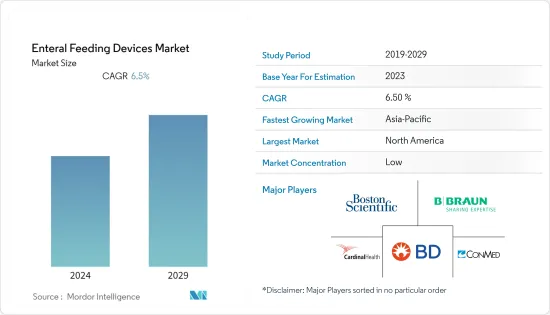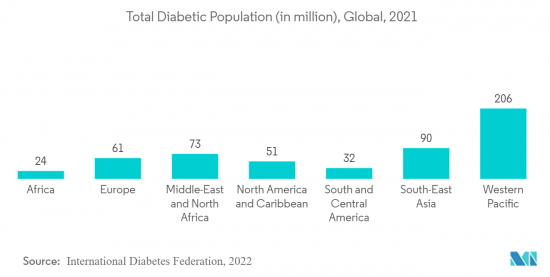 |
市場調査レポート
商品コード
1404089
経腸栄養デバイス - 市場シェア分析、産業動向・統計、2024年~2029年成長予測Enteral Feeding Devices - Market Share Analysis, Industry Trends & Statistics, Growth Forecasts 2024 - 2029 |
||||||
● お客様のご希望に応じて、既存データの加工や未掲載情報(例:国別セグメント)の追加などの対応が可能です。 詳細はお問い合わせください。
| 経腸栄養デバイス - 市場シェア分析、産業動向・統計、2024年~2029年成長予測 |
|
出版日: 2024年01月04日
発行: Mordor Intelligence
ページ情報: 英文 120 Pages
納期: 2~3営業日
|
- 全表示
- 概要
- 目次
経腸栄養デバイス市場の予測期間中のCAGRは6.50%。
COVID-19の大流行は経腸栄養デバイス市場に大きな影響を与えました。正常な腸管粘膜の障害により、COVID-19に罹患した患者は極度の体調不良に陥り、栄養吸収が低下しました。例えば、国立医学図書館が2022年3月に発表した調査論文によると、患者はかなりのレベルの炎症、ストレス、異化を起こし、タンパク質とカロリーの必要性が著しく上昇しました。このような患者の栄養失調を防ぐには、早急な経腸栄養サポートと十分な栄養素の供給が不可欠でした。ICUにおける栄養に関する欧州臨床栄養代謝学会(ESPEN)のガイドラインによると、重度のCOVID-19患者には胃経腸栄養が勧められます。できればICU入室後48時間以内に流量調整器付きポンプを用いて行うべきです。したがって、COVID-19の大流行により、特に集中治療室での経腸栄養装置の必要性が高まった。したがって、市場は予測期間中安定した成長が見込まれます。
市場成長の要因としては、高齢者人口の増加や加齢に伴う慢性疾患の増加、未熟児出産の増加、在宅療養環境における経腸栄養需要の増加などが挙げられます。例えば、米国疾病管理センター(CDC)の早産に関する最新情報によると、2022年11月、2021年に米国で出生した乳児の約10人に1人が早産に罹患しました。2021年の早産率は4%上昇しました。アフリカ系アメリカ人女性の早産率(14.8%)は、2021年の白人女性やヒスパニック系女性の早産率(それぞれ9.5%、10.2%)よりも約50%高かったです。早産は栄養失調の進行と関連することが多いため、これらの統計は経腸栄養デバイスの需要が今後数年間で増加すると予測されることを示しています。
さらに、製品の発売、合併、買収、提携など、主要な市場参入企業によるさまざまな取り組みが、予測期間中の市場の成長を後押しすると予想されます。例えば、2021年9月、Vonco Products LLCは、特許取得済みのEnteraLoc Flowダイレクトコネクト経腸栄養デリバリーシステムが米国食品医薬品局(FDA)から510(k)クリアランスを付与されたことを報告しました。このような製品認可は市場に大きな影響を与え、市場の成長を促進すると予想されます。

老年人口の増加や加齢に伴う慢性疾患の増加、早産児の増加、在宅介護の現場における経腸栄養の需要の高まりなど、上記のような要因が、世界中で経腸栄養デバイス市場の成長を促進すると予想されます。しかし、経腸栄養チューブに伴う合併症やヘルスケア償還の問題が、市場の成長を抑制する主な要因となっています。
経腸栄養デバイス市場動向
糖尿病セグメントは予測期間中に大幅な成長が見込まれる
糖尿病患者における経腸栄養は、高血糖、ケトアシドーシス、低血糖、飢餓による異化のリスクから生じる特定の特殊性があります。糖尿病分野は、糖尿病負担の増加や市場参入企業による戦略的イニシアチブの実施拡大などの要因により、予測期間中に大幅な成長が見込まれます。
国際糖尿病連合(IDF)による2021年の最新情報によると、2021年には約5億3,700万人の成人(20~79歳)が糖尿病に罹患しています。また同じ情報源によると、糖尿病患者の総数は2030年までに6億4,300万人、2045年までに7億8,300万人に増加すると予測されています。経腸栄養は、エネルギー、タンパク質、ビタミン、ミネラルといった必要なマクロおよび微量栄養素を供給することで、糖尿病患者の栄養不良のリスクを軽減するという重要な役割を果たしています。従って、経腸栄養補給装置の需要は、糖尿病患者集団の間で間もなく増加すると思われます。
さらに、Reviews in Endocrine and Metabolic Disordersが2022年3月に発表した論文によると、糖尿病/高血糖患者の管理は困難であり、特定の栄養アプローチが必要です。この栄養所要量は、経腸栄養補給によって満たすことができます。したがって、栄養所要量の増加は経腸栄養デバイスの需要を増加させ、それによって市場の成長を促進すると予想されます。
このように、糖尿病の負担増と栄養要求量の増加といった上記の要因は、分析期間を通じて同セグメントの成長を後押しすると予測されます。

北米は予測期間中、経腸栄養デバイス市場で大きな成長を維持する見込み
北米地域は、慢性疾患や外科手術の負担増加などの要因により、予測期間にわたって経腸栄養デバイス市場で大きなシェアを占めると予想されています。例えば、国際糖尿病連合(IDF)のDiabetes Atlas, 第10版の統計によると、2021年には、北米では成人の7人に1人(5,100万人)が糖尿病を患っています。北米では、成人の糖尿病患者数は2030年までに5,700万人、2045年までに6,300万人に達すると予想されています。糖尿病患者は入院リスクが3倍高くなる可能性が高いです。脳卒中など、糖尿病の不適切な管理がもたらす多くの結果によって、経腸栄養が必要となる可能性があります。同様に、カナダがん協会が発表したデータによると、2022年には約4,100人のカナダ人が胃がんと診断されると推定されています。したがって、このような統計は、国内の栄養管理のための経腸栄養デバイスの需要が今後数年間で増加し、最終的に市場の成長を後押しすることを示しています。
さらに、市場企業は市場成長に貢献する様々な戦略に取り組んでいます。例えば、2021年5月、QMDはDegania経腸栄養製品ポートフォリオに経鼻胃管を追加したことを報告しました。経鼻胃管は、高級材料から製造され、患者の安全性向上のためにENFit接続規格に準拠するように設計されています。同様に、2021年9月、Vonco ProductsのEnteraLoc Flow直接接続経腸栄養デリバリーシステムは、米国食品医薬品局(USFDA)から510(K)クリアランスを取得しました。このシステムは、漏れ防止シール付きパウチ、Voncoの直接接続式ENFitデバイス、食事供給用チューブを備えており、病院や在宅介護環境で栄養を供給することができ、ほとんどの食事要件を満たすように調整することができます。
そのため、慢性疾患の負担増加や外科手術の増加など、上記の要因により、予測期間中に市場は大きな成長を遂げることが予想されます。
経腸栄養デバイス産業の概要
経腸栄養デバイス市場は、世界的および地域的に事業を展開する複数の企業が存在するため、その性質上断片化されています。市場参入企業には、B. Braun Melsungen AG、Boston Scientific Corporation、Conmed Corporation、Cardinal Health、Becton Dickinson and Companyなどがあります。
その他の特典:
- エクセル形式の市場予測(ME)シート
- 3ヶ月間のアナリストサポート
目次
第1章 イントロダクション
- 調査の前提条件と市場定義
- 調査範囲
第2章 調査手法
第3章 エグゼクティブサマリー
第4章 市場力学
- 市場概要
- 市場促進要因
- 高齢者人口の増加と加齢に伴う慢性疾患
- 未熟児出産の増加
- 在宅ケアにおける経腸栄養の需要拡大
- 市場抑制要因
- 経腸栄養チューブに伴う合併症
- ヘルスケア償還の問題
- ポーターのファイブフォース分析
- 新規参入業者の脅威
- 買い手・消費者の交渉力
- 供給企業の交渉力
- 代替品の脅威
- 競争企業間の敵対関係の強さ
第5章 市場セグメンテーション(市場規模)
- 製品タイプ別
- 経腸栄養ポンプ
- 経腸栄養チューブ
- その他の製品タイプ
- 年齢層別
- 成人
- 小児科
- エンドユーザー別
- 病院
- 外来医療サービス
- その他エンドユーザー
- 用途別
- 腫瘍学
- 神経学
- クリティカルケア
- 糖尿病
- 消化器内科
- その他
- 地域
- 北米
- 米国
- カナダ
- メキシコ
- 欧州
- ドイツ
- 英国
- フランス
- イタリア
- スペイン
- その他の欧州
- アジア太平洋
- 中国
- 日本
- インド
- オーストラリア
- 韓国
- その他のアジア太平洋
- 中東・アフリカ
- GCC
- 南アフリカ
- その他の中東・アフリカ
- 南米
- ブラジル
- アルゼンチン
- その他の南米
- 北米
第6章 競合情勢
- 企業プロファイル
- Abbott Laboratories
- B. Braun Melsungen AG
- Boston Scientific Corporation
- Conmed Corporation
- Cook Medical Inc.
- Fresenius SE & Co. KGaA
- Halyard Health Inc.
- Nestle SA
- Avanos Medical Inc.
- Cardinal Health Inc.
- Becton Dickinson and Company
- Vygon SA
- Applied Medical Technology Inc.
- Amsino International Inc.
- Fidmi Medical
- ALCOR Scientific Inc.
第7章 市場機会と今後の動向

The enteral feeding devices market registered a CAGR of 6.50% over the forecast period.
The COVID-19 pandemic significantly impacted the enteral feeding devices market. Due to the disturbance of the normal intestinal mucosa, patients with COVID-19 who were extremely unwell had reduced nutrient absorption. For instance, according to a research article published by the National Library of Medicine in March 2022, patients had considerable levels of inflammation, stress, and catabolism, as well as a marked rise in their need for protein and calories. Immediate enteral nutrition support and the provision of sufficient nutrients were essential to prevent malnutrition in these patients. According to guidelines by the European Society for Clinical Nutrition and Metabolism (ESPEN) on nutrition in the ICU, gastric enteral nutrition was advised for severe COVID-19 patients. It should preferably be performed using a pump with a flow regulator within 48 hours of admission to the ICU. Hence, the COVID-19 pandemic increased the need for enteral feeding devices, especially for those in intensive care units. Hence, the market is expected to have stable growth over the forecast period.
The factors responsible for the market's growth include the growing geriatric population and age-related chronic diseases, the increasing number of premature births, and the growing demand for enteral feeding in home care settings. For instance, according to the Center for Disease Control (CDC) update on Preterm birth, in November 2022, preterm birth affected about 1 of every 10 infants born in the United States in 2021. The preterm birth rate rose 4% in 2021. The rate of preterm birth among African-American women (14.8%) was about 50% higher than the rate of preterm birth among white or Hispanic women (9.5% and 10.2% respectively) in 2021. Since preterm birth is frequently associated with the progressive development of malnutrition, these statistics indicate that the demand for enteral feeding devices is anticipated to increase over the coming years.
Additionally, various initiatives taken by the key market players, such as product launches, mergers, acquisitions, and partnerships, are expected to boost the market's growth during the forecast period. For instance, in September 2021, Vonco Products LLC reported that the patented EnteraLoc Flow direct-connect enteral nutritional delivery system was granted 510(k) clearance by the U.S. Food and Drug Administration (FDA). Such product clearance is expected to significantly impact the market, thereby driving the market's growth.
The above-mentioned factors, such as the growing geriatric population and age-related chronic diseases, the increasing number of premature births, and the growing demand for enteral feeding in home care settings, are expected to drive the enteral feeding device market growth across the world. However, complications associated with enteral feeding tubes and healthcare reimbursement issues are the major factors restraining the market's growth.
Enteral Feeding Devices Market Trends
Diabetes Segment Is Expected to Witness Significant Growth Over the Forecast Period
Enteral nutrition in people with diabetes has certain specificities that arise from the risk of hyperglycemia, ketoacidosis, hypoglycemia, and a fast shift to catabolism upon starvation. The diabetes segment is expected to witness substantial growth during the forecast period attributed to factors such as the increasing burden of diabetes and the growing implementation of strategic initiatives by market players.
As per a 2021 update by the International Diabetes Federation (IDF), approximately 537 million adults (20-79 years) had diabetes in 2021. The same source also reported that the total number of people living with diabetes is projected to rise to 643 million by 2030 and 783 million by 2045. Enteral nutrition plays an important role in reducing the risk of malnutrition in diabetic patients by providing the necessary macro and micronutrients, such as energy, protein, vitamins, and minerals. Thus, the demand for enteral feeding devices will likely increase among the diabetic patient population shortly.
Furthermore, according to an article published by Reviews in Endocrine and Metabolic Disorders in March 2022, the management of patients with diabetes/hyperglycemia is challenging and requires a specific nutritional approach, the purpose of which is to fulfill the nutritional requirements while maintaining optimal glycemic control. This nutritional requirement can be fulfilled by enteral nutrition feeding. Thus, increasing nutritional requirements is expected to increase the demand for enteral feeding devices, thereby driving market growth.
Thus, the factors above, such as the increasing burden of diabetes coupled with increased nutritional requirements, are anticipated to boost the segment's growth throughout the analysis period.

North America Expected to Hold a Significant Growth in the Enteral Feeding Devices Market Over The Forecast Period
The North American region is expected to hold a significant share in the enteral feeding devices market over the forecast period due to factors such as an increase in the burden of chronic diseases and surgical procedures. For instance, as per statistics by the International Diabetes Federation (IDF) Diabetes Atlas, 10th Edition, in 2021, 1 in 7 adults (51 million) are living with diabetes in North America. The number of adults with diabetes is expected to reach 57 million by 2030 and 63 million by 2045 in North America. Patients with diabetes are likely to have a threefold higher risk of being hospitalized. Many consequences of improperly managed diabetes, such as stroke, can necessitate enteral feeding. Likewise, as per the data published by the Canadian Cancer Society, in 2022, it was estimated that around 4,100 Canadians would be diagnosed with stomach cancer. Thus, such statistics indicate that the demand for enteral feeding devices for nutrition management within the country will increase over the coming years, ultimately boosting the market growth.
Moreover, market players are engaged in various strategies contributing to market growth. For instance, in May 2021, QMD reported the addition of Nasogastric Tubes to its Degania Enteral Feeding Product Portfolio. Nasogastric tubes are manufactured from premium materials and designed to comply with ENFit connection standards for improved patient safety. Likewise, in September 2021, Vonco Products' EnteraLoc Flow direct-connect enteral nutritional delivery system received 510 (K) clearance from the United States Food and Drug Administration (USFDA). The system, which features a pouch with a leak-proof seal, Vonco's direct-connect ENFit device, and a tube for food delivery, can deliver nutrition in a hospital or home care setting and can be tailored to meet most dietary requirements.
Thus, the market is expected to witness significant growth over the forecast period due to the above-mentioned factors, such as an increase in the burden of chronic diseases and surgical procedures.
Enteral Feeding Devices Industry Overview
The enteral feeding devices market is fragmented in nature due to the presence of several companies operating globally and regionally. The companies in the market include B. Braun Melsungen AG, Boston Scientific Corporation, Conmed Corporation, Cardinal Health, and Becton Dickinson and Company, among others.
Additional Benefits:
- The market estimate (ME) sheet in Excel format
- 3 months of analyst support
TABLE OF CONTENTS
1 INTRODUCTION
- 1.1 Study Assumptions and Market Definition
- 1.2 Scope of the Study
2 RESEARCH METHODOLOGY
3 EXECUTIVE SUMMARY
4 MARKET DYNAMICS
- 4.1 Market Overview
- 4.2 Market Drivers
- 4.2.1 Growing Geriatric Population and Age Related Chronic Diseases
- 4.2.2 Increasing Number of Premature Births
- 4.2.3 Growing Demand for Enteral Feeding in Home Care Settings
- 4.3 Market Restraints
- 4.3.1 Complications Associated with Enteral Feeding Tubes
- 4.3.2 Healthcare Reimbursement Issues
- 4.4 Porter's Five Forces Analysis
- 4.4.1 Threat of New Entrants
- 4.4.2 Bargaining Power of Buyers/Consumers
- 4.4.3 Bargaining Power of Suppliers
- 4.4.4 Threat of Substitute Products
- 4.4.5 Intensity of Competitive Rivalry
5 MARKET SEGMENTATION (Market Size by Value- USD million)
- 5.1 By Product Type
- 5.1.1 Enteral Feeding Pumps
- 5.1.2 Enteral Feeding Tubes
- 5.1.3 Other Product Types
- 5.2 By Age Group
- 5.2.1 Adults
- 5.2.2 Pediatrics
- 5.3 By End User
- 5.3.1 Hospitals
- 5.3.2 Ambulatory Care Services
- 5.3.3 Other End Users
- 5.4 By Application
- 5.4.1 Oncology
- 5.4.2 Neurology
- 5.4.3 Critical Care
- 5.4.4 Diabetes
- 5.4.5 Gastroenterology
- 5.4.6 Other Applications
- 5.5 Geography
- 5.5.1 North America
- 5.5.1.1 United States
- 5.5.1.2 Canada
- 5.5.1.3 Mexico
- 5.5.2 Europe
- 5.5.2.1 Germany
- 5.5.2.2 United Kingdom
- 5.5.2.3 France
- 5.5.2.4 Italy
- 5.5.2.5 Spain
- 5.5.2.6 Rest of Europe
- 5.5.3 Asia-Pacific
- 5.5.3.1 China
- 5.5.3.2 Japan
- 5.5.3.3 India
- 5.5.3.4 Australia
- 5.5.3.5 South Korea
- 5.5.3.6 Rest of Asia-Pacific
- 5.5.4 Middle East and Africa
- 5.5.4.1 GCC
- 5.5.4.2 South Africa
- 5.5.4.3 Rest of Middle East and Africa
- 5.5.5 South America
- 5.5.5.1 Brazil
- 5.5.5.2 Argentina
- 5.5.5.3 Rest of South America
- 5.5.1 North America
6 COMPETITIVE LANDSCAPE
- 6.1 Company Profiles
- 6.1.1 Abbott Laboratories
- 6.1.2 B. Braun Melsungen AG
- 6.1.3 Boston Scientific Corporation
- 6.1.4 Conmed Corporation
- 6.1.5 Cook Medical Inc.
- 6.1.6 Fresenius SE & Co. KGaA
- 6.1.7 Halyard Health Inc.
- 6.1.8 Nestle SA
- 6.1.9 Avanos Medical Inc.
- 6.1.10 Cardinal Health Inc.
- 6.1.11 Becton Dickinson and Company
- 6.1.12 Vygon SA
- 6.1.13 Applied Medical Technology Inc.
- 6.1.14 Amsino International Inc.
- 6.1.15 Fidmi Medical
- 6.1.16 ALCOR Scientific Inc.
